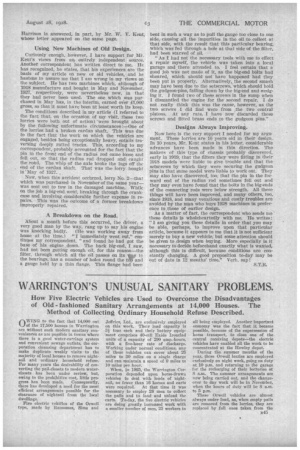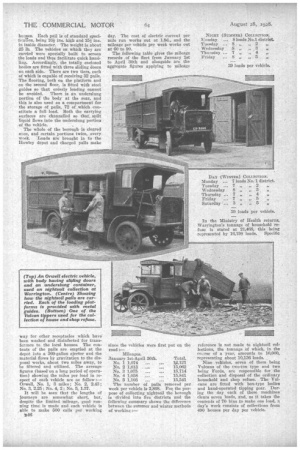WARRINGTON'S UNUSUAL SANITARY PROBLEMS.
Page 29

Page 30

If you've noticed an error in this article please click here to report it so we can fix it.
How Five Electric Vehicles are Used to Overcome the Disadvantages of Old fashioned Sanitary Arrangements at 14,000 Houses. The Method of Collecting Ordinary Household Refuse Described.
OIVING to the fact that 14,000 out ILof the 17,500 houses in Warrington are without such modern sanitary conveniences as are possible in towns where there is a good water-carriage system and convenient sewage outlets, the corporation cleansing department has to make duplicate weekly visits to the majority of local houses to remove nightsoil and ordinary household refuse. For many years the desirability of converting the pail-closets to modern waterclosets has been under review, but, owing to the prohibitive cost, little pro
gress has been made. Consequently, there has developed a need for the most efficient arrangements possible for the clearance of nightsoil from the local dwellings.
Five electric vehitles of the Orwell type, made by Itansomes, Sims and
Jeffries, Ltd., are exclusively employed on this work. Their load capacity is 31 tons each and their battery equipment comprises 40-cell Exide Ironclad units of a capacity of 290 amp.-hours, with a five-hour rate of discharge. Working under normal conditions, any of these vehicles can cover about 25 miles to 30 miles on a single charge and can maintain a speed of 9 miles to 10 miles per hour.
When, in 1925, the Warrington Corporation depended upon horse-drawn vehicles to deal with loads of nightsoil, no fewer than 16 horses and carts were required. At that time it was necessary to employ 28 men to collect the pails and to load and unload the carts. To-day, the five electric vehicles are doing greatly increased work with a smaller number of men, 25 workers in
all being employed. Another important economy was the fact that it became possible, because of the supersession of horse transport, to close one of the central receiving depots—the electric vehicles have enabled all the work to be concentrated at the Howley depot.
'During the summer mouths of the year, these Orwell lorries are employed exclusively on night work, going on duty at 10 p.m. and returning to the garage for the recharging of their batteries at 8 a.m. The summer arrangements are now being carried out, and the changeover to day work will be in November, when the hours of duty will be 8 a.m. to 5 P.m These Orwell vehicles are almost always under load, as, when empty pails are removed from the lorries, they are replaced by full ones taken from the houses. Each pail is of standard speciiieaTion, being 16i ins, high and 15i ins. in inside diameter. The weight is about 25 lb. The vehicles on which they are carried were specially built to screen the loads and thus facilitate quick handling. Accordingly, the totally enclosed bodies are fitted with three sliding doors on each side. There are two tiers, each of which is capable of receiving 32 pails. The flooring, both on the platform and on the second floor, is fitted with steel guides so that orderly loading cannot be avoided. There is an underslung portion of the body at the rear, and this is also used as a compartment for the storage of pails, 72 of which constitute a full load. Both the carrying surfaces are channelled so that spilt liquid flows into the underslung portion of the vehicle.
The whole of the borough is cleared omee, and certain portions twice, every week. 'Loads are brought in to the Howley depot and charged pails make
way for other receptacles which have been washed and disinfected for transference to the local houses. The contents of the pails are emptied at the depot into a 360-gallon ejector and the material flows by gravitation to the disposal works, about two miles away, to be filtered and utilized. The average figures (based on a long period of operation) showing the miles per load in respect of each vehicle are as follow :Orwell, No. 1, 3 miles ; No. 2, 2.43; No. 3, 2.25; No. 4, 2; No. 5, 1.37.
It will be seen that the lengths of journeys are somewhat short, but, despite the limited mileage, good running time is made and each vehicle is able to make 500 calls per working 1346 day. The cost of electric current per mile run works out at 1.9d., and the mileage per vehicle per week works out at 60 to 90.
The following table gives the mileage records of the fleet from January 1st to April 30th and alongside are the aggregate figures applying to mileage
The number of pails removed per week per vehicle is 2,808. Fo, the purpose of collecting nightsoil the borough is divided into five districts and the following summary shows the difference between the summer and winter methods of working :—
NIGHT (SUMMER) COLT.ECTION.
Eonday ... 8 loads No.1 district Tuesday ... 8 „ „ 2 „ Wednesday 8 „ „ 3 20 Thursday ... 7 „ „ 4 ,2 Friday ... 8 „ „ 5 Pi
DAY (WINTER) COLLECTION.
Monday ... 7 loads No. 1 district. Tuesday ... 7 „ „ 2 Wednesday 8 „ „ 3 Thursday -. 7 „ „ 4 Friday ... 7 „ 5 Saturday ... 3 „ 39 loads per vehicle.
In the Ministry of Health returns, Warrington's tonnage of household -re7 fuse is stated at 21,468, this being
represented by 16,198 loads. Specific reference is not made to nightsoil collections, the tonnage of which, in the coGrse of a year, amounts to 10,000, representing about 10,136 loads.
Nine vehicles, seven of them being Vuleans of the two-ton type and two being Fords, are responsible for the collection and disposal of the ordinary household and shop refuse. The Vu!cans are fitted with box-type bodies and hand-operated tipping gear. During the day each of these machines clears seven loads, and, as it takes the contents of 70 bins to make one load, a day's work consists of collections from 490 houses per day per vehicle.
































